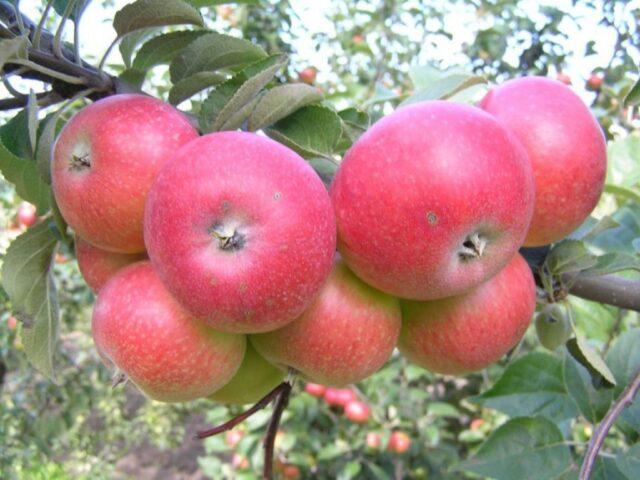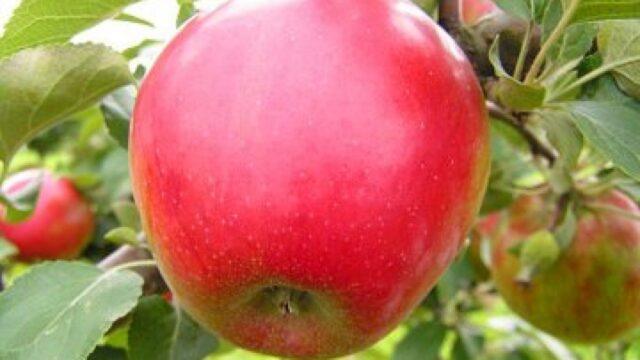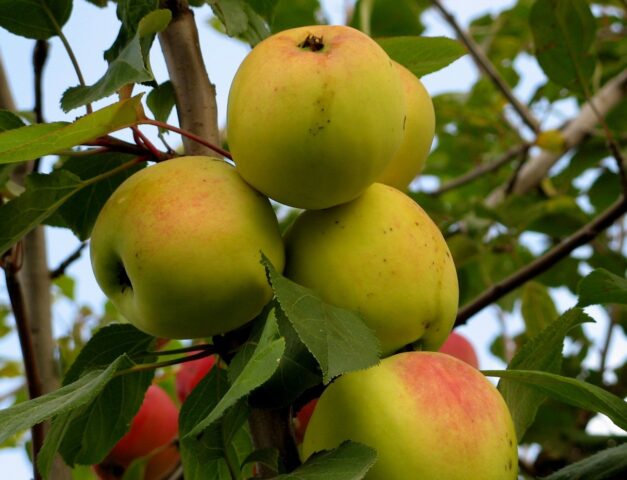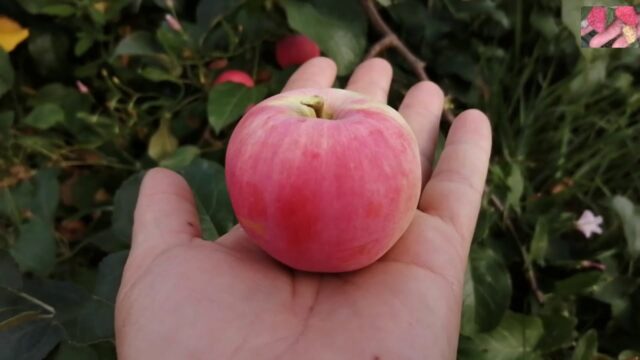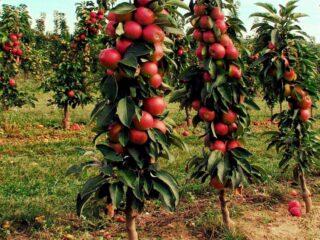Content
- 1 Which apple tree variety is best to choose for Siberia
- 2 The best varieties of apple trees for Siberia with photos and descriptions
- 2.1 Frost-resistant apple tree varieties for Siberia
- 2.2 Sweet and large varieties of apple trees for Siberia
- 2.3 Summer (early) varieties of apple trees for Siberia
- 2.4 Autumn varieties of apple trees for Siberia
- 2.5 Late varieties of apple trees for Siberia
- 2.6 Low-growing varieties of apple trees for Siberia
- 2.7 Self-fertile varieties of apple trees for Siberia
- 2.8 The newest varieties of apple trees for Siberia
- 2.9 Semi-cultivated apple trees for Siberia
- 3 Conclusion
The apple tree is the most common fruit tree in Russia. However, the opportunity to grow it in Siberian conditions appeared not so long ago, namely at the beginning of the 19th century. This was possible thanks to the efforts of breeders who were able to create species characterized by high resistance to negative external factors. However, winter-hardy varieties of apple trees for Siberia have some differences in ripening time, taste and other characteristics. Therefore, in order not to make a mistake with the choice, it is necessary to study the characteristics of the most popular types of fruit trees for this region of the country.

Apple trees for growing in Siberia must have high vital potential
Which apple tree variety is best to choose for Siberia
The climate of this region is sharply continental, with significant differences in annual and daily temperatures. Winters here are long and cold, and summers are short and hot.Transitional seasons in Siberia, autumn and spring, are less pronounced. But the main advantage of the Siberian climate is that in the cold season the snow cover is more than 20 cm, which is a protective layer for the root system of trees. There is also low air humidity here, so low temperatures are tolerated by plants much more easily.
To successfully grow apple trees in Siberia, it is necessary to choose varieties that have the following qualities:
- resistance to low temperatures and sudden changes;
- do not require a lot of light and regular watering;
- stable yield;
- short growing season;
- low susceptibility to diseases and pests;
- compact size of the tree.
Also, when choosing a type, you need to take into account its taste and the duration of storage of the crop.
The best varieties of apple trees for Siberia with photos and descriptions
To better understand which varieties of apples are suitable for Siberia, it is necessary to study the main characteristics of popular types. And taking this into account, select the most optimal options.
Frost-resistant apple tree varieties for Siberia
All Siberian varieties of apple trees are divided into three main categories based on frost resistance. The hardiest ones can withstand temperatures lower than -40 °C. Therefore, they can be grown even in the northern part of the region, where the climate is the harshest.
The second category includes species whose frost resistance is at the level of -30-35 °C. They are able to fully develop and bear fruit in Western Siberia. And the third group includes apple trees, which produce large, tasty fruits, but are able to withstand temperatures as low as -25 °C. Therefore, they are best grown in the eastern part of Siberia, where weather conditions are more benign.
The best varieties of apple trees for Eastern, Northern and Western Siberia include:
- Altai beauty. A medium-sized tree with straight branches pointing upward. The crown is rounded. This Altai apple variety is ideal for Siberia and is characterized by an accelerated growth rate. It begins bearing fruit at the age of five years. The fruits have a regular round shape, weighing about 75 g. They are whitish in color with a red blush on most of the fruit. The taste is sweet and sour with a medium aroma. The tasting score is 4.6 points out of a possible 5.
Altai beauty is highly resistant to scab
- Bayana. A medium-sized tree, the height of which at the age of ten is 3 m, and the maximum is about 4.5 m. The annual growth is 6-11 cm. The crown is medium dense with a growth diameter of 3.5 m. The fruits are round, weakly ribbed, and are highly marketable. The skin is smooth, dense, and you can feel it a little when eaten. The average weight of Bayan's apples is 90-140 g. The apple tree is considered a mid-late autumn one. Harvesting is recommended in the first ten days of September.
The Bayan apple tree begins to bear fruit 3-4 years after planting
- Mountain synapse. The tree is medium-sized, fast-growing. The crown is round, the shoots in it are located compactly. The fruits are medium-sized, one-dimensional, flattened. Their weight varies between 97-120 g. The color of Mountain Sinap apples is golden yellow, the blush is slight brownish-red. The pulp is white, fine-grained, medium density, juicy. The taste is sweet and sour, the aroma is moderate. Mountain sinap is a late-autumn species of apple tree. The harvest ripens at the end of September. Tasting score: 4.7 points.
The yield of Mountain Sinap reaches 300 kg per tree
- Surkhurai. Summer species with high frost resistance.The tree is medium-sized with a rounded crown. The apple tree begins to bear fruit in the fourth year after planting. Its annual growth is 8-9 cm. The apples of the Surkhurai variety are round-flat, one-dimensional, slightly sloping. They have a golden yellow color with a crimson striped blush that covers the entire surface of the fruit. The pulp is tender, creamy, juicy, fine-grained. The taste is sweet and sour.
The Surkhurai harvest ripens by the end of August
- Bow to Shukshin. A medium-sized tree with a rounded crown, up to 4.5 m high. Belongs to the category of autumn apple trees. The harvest ripens in the first ten days of September. The apple tree begins to bear fruit 4-5 years after planting. Productivity reaches 57 kg per tree. The fruits are flattened, truncated-conical in shape. Their average weight is 80-140 g. The main color is greenish, the outer color is pink with dark strokes. The taste is rated as good, sweet and sour.
The Poklon Shukshin apple tree harvest retains its consumer properties for two months
Sweet and large varieties of apple trees for Siberia
Among all species, large-fruited apple trees with high taste are especially popular. However, such trees are not highly frost-resistant and require more careful care.
The best varieties of large-fruited apple trees for Siberia with photos:
- Melba. Canadian variety of late summer ripening. The tree is medium-sized, with a rounded crown. Melba has a mixed type of fruiting. The apples are flattened, round-conical, slightly ribbed. Their size is above average. The skin is smooth, tender with a waxy coating. The color is light green with red striped blush.The harvest ripens by the end of August.
Melba bears fruit annually at an early age
- Welsey. An American apple variety that can be grown in Siberia. It is characterized by early fruiting and begins to produce apples at 4-5 years. The harvest volume of an adult tree is 200 kg. The weight of Welsey apples varies between 80-150 g. The fruits are flat-round, cherry-red in color, sweet and sour, with a pleasant aroma. The skin is thin and dense. Welsey's tasting score is 3.9 points. The fruits ripen by the third ten days of September.
The Welsie variety has smooth ripening of apples
- White filling. A time-tested, large-fruited apple tree variety of Russian selection, which is also suitable for Siberia. The tree is medium-sized, grows up to 4 m in Siberian conditions. The crown of the apple tree is broadly pyramidal and becomes rounder as it matures. The fruits of the White filling are conical and equilateral. The color is greenish-white, but on the sunny side there is a slight blush. The average weight of apples is 120-150 g.
White filling has a wide, deep funnel that is rusty
- Moscow Grushovka. It is a large-growing tree, but in Siberian conditions its height does not exceed 4.5 m. The crown of the apple tree is branched with drooping branches. The foliage cover of Grushovka Moscow is dense. The fruits are medium-sized, weighing up to 120 g. Their shape is spherical, slightly flattened, the saucer is almost flat, wide. The color of apples ranges from light green to pale lemon. Cover red, striped.
Moscow pear is characterized by a high content of vitamins in its fruits
- Aport. An ancient variety with early winter ripening. The tree is tall, with an accelerated rate of development. The Aport apple tree begins to bear fruit in the fifth year on twigs and alternating ringlets.The crown is wide-rounded, thickened. The fruits are flattened-conical, with weak ribbing. Their average weight reaches 200-260 g. The color is yellow with green, the outer skin is dark red in the form of dark streaks.
Aport apples acquire a balanced taste a month after being picked
Summer (early) varieties of apple trees for Siberia
Rooted apple trees fall into this category. They bloom in early May and begin to bear fruit in August. However, such types are not suitable for long-term saving. Their apples retain their consumer properties for 15-20 days.
The best summer varieties of apple trees for Eastern and Western Siberia:
- Ranetka Ermolaeva;
Ranetka Ermolaeva is suitable for processing and conservation
- Altai crimson;
Altai crimson has the ability to quickly recover when frozen
- Zhebrovskoe;
Zhebrovskoye is a small-fruited variety that has a rich aroma
- Minusinsk red;
Minusinsky red fruits do not fall off when ripe
- Alyonushka.
Alyonushka - a fast-growing semi-dwarf
Autumn varieties of apple trees for Siberia
Autumn varieties, unlike summer ones, have increased winter hardiness, which is important in the conditions of Siberia. The harvest ripens in September. Apples of autumn varieties can be stored for 1-3 months.
The best autumn varieties of apple trees for Siberia:
- Tolunay;
Tolunay has excellent taste
- Ural liquid;
Ural liquid gives the first harvest for 2-3 years
- Lungwort;
Lungwort has high natural immunity
- Treasured;
Apples of the Treasured variety have a strawberry flavor
- Northern Sinap.
Northern Sinap is only suitable for Eastern Siberia
Late varieties of apple trees for Siberia
These types of crops are distinguished not only by high winter hardiness, but also by a long growing season. Their fruits reach removable maturity only at the end of September. After picking, apples need to ripen for 1-2 months.
Late varieties of apple trees that are suitable for Siberia:
- Isetskoye later;
Isetskoye is later stored until February
- Beauty of Sverdlovsk;
The beauty of Sverdlovsk bears fruit every year
- Danila;
The Danila variety is resistant to scab
- Good news;
Apples of the Good News variety can last until April.
- Snowdrop.
Snowdrop yield is 80 kg per tree
Low-growing varieties of apple trees for Siberia
For the full development of the apple tree in Siberia, the short stature of the tree is very important. Because in this case its crown will suffer less from cold winds and freeze. This is especially true for the western and northern parts of the region, where climatic conditions are far from ideal.
Low-growing varieties of apple trees that are best planted in Siberia:
- Altai ruddy;
The Altai ruddy harvest can be preserved for up to three months
- Palmetta;
Palmette is characterized by regular fruiting
- Sissy;
The height of the Nezhenka apple tree does not exceed 2.5 m
- Siberian souvenir;
The Siberian souvenir harvest is suitable for fresh consumption and processing
Self-fertile varieties of apple trees for Siberia
When choosing a variety, it is necessary to take into account that the weather conditions of the region are not always conducive to timely pollination of apple tree flowers.Therefore, it is recommended to give preference to self-fertile types of crops, which guarantees a stable ovary.
These include:
- Red bunch;
The Red Bunch variety needs preventive treatment against scab.
- The beauty of the steppe;
The yield of juice based on Krasa Steppe apples is 68%
- Firstborn of Buryatia;
The firstborn of Buryatia gives the first harvest at the age of four years
- Glory to Buryatia.
The glory of Buryatia is characterized by small fruits
The newest varieties of apple trees for Siberia
Thanks to selection, the number of crop varieties that develop well in Siberian conditions increases every year. When creating new species, the goal is to obtain highly productive frost-resistant apple trees with improved taste characteristics of the fruit.
New promising varieties:
- Chupinskoe;
The content of ascorbic acid in Chupinsky fruits reaches 17.78 mg per 100 g
- Augusta;
Augusta is characterized by precociousness
Rozhdestvenskoe.Rozhdestvensky fruits have a beautiful appearance
Semi-cultivated apple trees for Siberia
Semi-cultivated apple trees are among the most popular types of crops grown in Siberia. They are characterized by an increased level of endurance, versatility of use and good taste of the fruit.
The best varieties of semi-cultivated apple trees for Western and Eastern Siberia: Alyonushka, Zavetnoye, Bayana, Altai Bagryanoye.
Conclusion
Having studied the winter-hardy varieties of apple trees for Siberia, as well as large-fruited types of crops for this region, you can select the best of them, which will delight you with regular fruiting. However, it is worth considering that the endurance of a tree directly depends not only on its natural immunity, but also on care, which must correspond to the stage of development of the tree.





